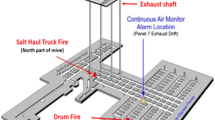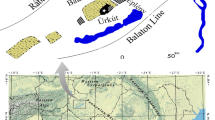Abstract
Bromine-82, Potassium-42 and Copper-64 have been successfully adopted as radioactive surrogates for outdoor large area contamination training. The goal of this project was to discover new materials that could supplement potassium bromide (KBr) and copper pellets in radiological dispersal device (RDD) training events to reduce the down time of the training fields and to broaden the toolbox of the RDD surrogates at Idaho National Laboratory. Of the ten different materials investigated, sodium nitrite, gallium metal, and gallium oxide presented the greatest promise due to their ability to meet or exceed selection criteria: half-lives (between 10 and 36 h), limited impurities (99.9%), and favorable National Fire Protection Agency (NFPA) rating.

Similar content being viewed by others
References
Harper FT, Musolino SV, Wente WB (2007) Realistic radiological dispersal device hazard boundaries and ramifications for early consequence management decisions. Health Phys 93:1–16
Coleman CN, Hrdina C, Bader JL, Norwood A, Hayhurst R, Forsha J, Yeskey K, Knebel A (2009) Medical response to a radiologic/nuclear event: integrated plan from the office of the assistant secretary for preparedness and response, department of health and human services. Ann Emerg Med 53:213–222
Green AR, Erhardt L, Lebel L, Duke MJM, Jones T, White D, Quayle D (2016) Overview of the full-scale radiological dispersal device field trials. Health Phys 110:403–417
Shin H, Kim J (2009) Development of realistic RDD scenarios and their radiological consequence analyses. Appl Radiat Isot 67:1516–1520
Musolino SV, Harper FT (2006) Emergency response guidance for the first 48 hours after the outdoor detonation of an explosive radiological dispersal device. Health Phys 90:377–385
Radiological attack: dirty bombs and other devices (2023) https://www.dhs.gov/xlibrary/assets/prep_radiological_fact_sheet.pdf. Accessed April 19,
Carney K, Finck M, McGrath C, Brush B, Jansen D, Dry D, Brooks G, Chamberlain D (2013) The development of radioactive sample surrogates for training and exercises. J Radioanal Nucl Chem 296:769–773
Vavrek JR, Hines CC, Bandstra MS, Hellfeld D, Heine MA, Heiden ZM, Mann NR, Quiter BJ, Joshi, T H Y (2024) Surrogate distributed radiological sources II: aerial measurement campaign. IEEE Trans Nuclear Sci https://doi.org/10.1109/TNS.2024.3351611
Gwin J (2012) Technical justification for the TRACER program at the Nevada national security site, National Security Technologies
Brown RL, Farfan EB, Jannik GT (2010) Assessment of F-18 use as a live radiological agent in field exercises. Savannah River National Laboratory
Haslip DS, Mercier JR (2004) A NATO exercise on radiological sampling. Health Phys 87:S63–S67
Cochran LD, Marianno CM (2018) Radionuclide selection for emergency response exercise at disaster city® using unsealed radioactive contamination. Health Phys 114:7–12
Baum EM, Ernesti MC, Knox HD, Miller TR, Watson AM (2010) Nuclides and isotopes: chart of the nuclides. Bechtel Marine Propulsion Corporation
Squibb KS, Fowler BA (1983) In: Fowler BA (ed) Chapter 7 - the toxicity of arsenic and its compounds, 1st edn. Elsevier, Amsterdam
Recommended list of common impurities for metallic fixed-point materials of the ITS-90 (2022) https://tsapps.nist.gov/publication/get_pdf.cfm?pub_id=832299. Accessed 11 Oct 2022
Author information
Authors and Affiliations
Corresponding author
Additional information
Publisher’s Note
Springer Nature remains neutral with regard to jurisdictional claims in published maps and institutional affiliations.
Supplementary Information
Below is the link to the electronic supplementary material.
Rights and permissions
About this article
Cite this article
Heiden, Z.M., Hines, C.C., Mann, N.R. et al. Investigation of candidates for reactor produced radioactive materials in support of radiological training exercises. J Radioanal Nucl Chem 333, 1231–1241 (2024). https://doi.org/10.1007/s10967-024-09371-3
Received:
Accepted:
Published:
Issue Date:
DOI: https://doi.org/10.1007/s10967-024-09371-3




